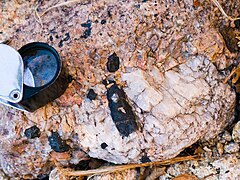Blue asbestos
| Riebeckite | |
|---|---|

Black riebeckite in an alkaline pegmatite from Lindinosa near Évisa, Corsica, France
|
|
| General | |
| Category | Silicate mineral |
|
Formula (repeating unit) |
Na2(Fe2+3Fe3+2)Si8O22(OH)2 |
| Crystal system | Monoclinic |
| Crystal class | Prismatic (2/m) (same H-M symbol) |
| Space group | C2/m |
| Unit cell | a = 9.76 Å, b = 18.04 Å c = 5.33 Å; β = 103.59°; Z = 2 |
| Identification | |
| Color | Black, dark blue; dark blue to yellow-green in thin section |
| Crystal habit | As prismatic crystals, commonly fibrous, asbestiform; earthy, massive |
| Twinning | Simple or multiple twinning parallel to {100} |
| Cleavage | Perfect on {110}, intersecting at 56° and 124°; partings on {100} and {010} |
| Fracture | Conchoidal to uneven |
| Tenacity | Brittle |
| Mohs scale hardness | 6 |
| Luster | Vitreous to silky |
| Streak | Pale to bluish gray |
| Diaphaneity | Semitransparent |
| Specific gravity | 3.28–3.44 |
| Optical properties | Biaxial (-) |
| Refractive index | nα = 1.680–1.698 nβ = 1.683–1.700 nγ = 1.685–1.706 |
| Birefringence | δ = 0.005–0.008 |
| Pleochroism | X = blue, indigo; Y = yellowish green, yellow brown; Z = dark blue |
| 2V angle | Measured: 68° to 85°, Calculated: 62° to 78° |
| Dispersion | Strong |
| References | |
Riebeckite is a sodium-rich member of the amphibole group of silicate minerals, chemical formula Na2(Fe2+3Fe3+2)Si8O22(OH)2. It forms a solid solution series with magnesioriebeckite. It crystallizes in the monoclinic system, usually as long prismatic crystals showing a diamond-shaped cross section, but also in fibrous, bladed, acicular, columnar, and radiating forms. Its Mohs hardness is 5.0–6.0, and its specific gravity is 3.0–3.4. Cleavage is perfect, two directions in the shape of a diamond; fracture is uneven, splintery. It is often translucent to nearly opaque.
It was first described in 1888 for an occurrence on Socotra Island, Aden Governorate, Yemen and named for German explorer Emil Riebeck (1853–1885).
It typically forms dark-blue elongated to fibrous crystals in highly alkali granites, syenites, rarely in felsic volcanics, granite pegmatites and schist. It occurs in banded iron formations as the asbestiform variety crocidolite (blue asbestos). It occurs in association with aegirine, nepheline, albite, arfvedsonite in igneous rocks; with tremolite, ferro-actinolite in metamorphic rocks; and with grunerite, magnetite, hematite, stilpnomelane, ankerite, siderite, calcite, chalcedonic quartz in iron formations.
...
Wikipedia
